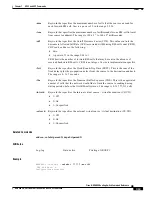
7-12
Cisco MGX 8850 Routing Switch Command Reference
Release 2.0, Part Number 78-10467-04 Rev C0, October 2001
Chapter 7
SPVC and SVC Commands
addcon
-frame
Frame discard: Enter a 1 to enable or a 0 to disable. The default is disabled (0).
-mc
Maximum cost (maxcost): a value that creates a priority for the connection route.
The switch can select a route only if the cost does not exceed maxcost. The range
for maxcost is 0–2147483647. If you do not specify maxcost, the connection has
the highest routing priority by default. Therefore, the maxcost parameter lets you
lower the routing priority of a connection. Note the following effects of values
in the maxcost rage:
•
To assign the highest priority to an SPVC based on cost (any path is
acceptable), enter 2147483647. You can achieve the same result by not
specifying maxcost at all, in which case the cost appears as a –1 in the
dspcon output. (You cannot enter a –1 for either maxcost in addcon or to
the cnfpnni-intf command, but display commands can show unspecified
values as –1.).
•
Enter a 0 for optimal (or least expensive) path.
•
For any non-zero maxcost, the switch assigns a path if the total cost for all
links does not exceed maxcost.
Although maxcost applies to an individual connection, routing costs
substantially depend on a cost-per-link that you specify at every PNNI logical
port in the network. The applicable PNNI command is cnfpnni-intf. (See the
description of the administrative weight parameter for cnfpnni-intf in the
chapter, “
PNNI Commands
.”
The cost of a route is as follows:
routing cost=sum of all costs-per-link
where:
•
The cost-per-link has been specified through cnfpnni-intf at the egress of
each logical port under PNNI control throughout the network. The impact
of cost-per-link is cumulative, not just local.
•
Each link has two egress points: one going to the far endpoint, and one in
the return direction. The cost-per-link can differ in each direction, so the
switch adds the cost-per-link in each egress instead multiplying cost by two.
The cost-per-link applies to all connections of a particular service type on a port.
For example, the cost-per-link is the same for all VBR.1 connections that PNNI
controls on a port, and this cost can differ from all UBR.1 connections on the
same port. Alternatively, you can use cnfpnni-intf to make the cost-per-link the
same for all service types.
To illustrate by examining a four-link route:
1.
You specify a maxcost of 100000.
2.
A potential route has four links for a total of eight egress points (four going
to the endpoint and four coming back).
3.
The cost-per-link at 6 ports is 5040 (the default) and 10000 at 2 ports.
The PXM45 would use the route because the resulting cost of 50240 is less than
the maxcost of 100000.
















































